36 DMV Questions of Rules of the Road
Note:
If you wish to check whether you have master these questions, you may
click on the button above to practice with questions only from this DMV topic.
If you do not have an account yet,
Sign Up one now, it is FREE!
1. When going straight ahead at a roundabout you should:
A. Indicate left before leaving the roundabout
B. Not indicate at any time
C. Indicate right when approaching the roundabout
D. Indicate left when approaching the roundabout
2. You are going along a single-track road with passing places only on the right. The driver behind wishes to overtake. You should:
A. Speed up to get away from the following driver
B. Switch on your hazard warning lights
C. Wait opposite a passing place on your right
D. Drive into a passing place on your right
3. You see this sign ahead of you. It means:
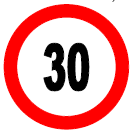 A. Start to slow down to 30 kph after passing itB. You are leaving the 30 kph speed limit areaC. Do not exceed 30 kph after passing itD. The minimum speed limit ahead is 30 kph
A. Start to slow down to 30 kph after passing itB. You are leaving the 30 kph speed limit areaC. Do not exceed 30 kph after passing itD. The minimum speed limit ahead is 30 kph
4. You are leaving your vehicle parked on a road. When may you leave the engine running?
A. If you will be parked for less than five minutes
B. If the battery is flat
C. When in a 20 mph zone
D. Not on any occasion
5. You are parked in a busy high street. What is the safest way to turn your vehicle around to go the opposite way?
A. Find a quiet side road to turn round in
B. Drive into a side road and reverse into the main road
C. Get someone to stop the traffic
D. Do a U-turn
6. What is the national speed limit on motorways, unless otherwise indicated, for cars and motorcycles?
A. 50mph
B. 60mph
C. 70mph
D. 80mph
7. You are intending to turn right at a junction. An oncoming driver is also turning right. It will normally be safer to:
A. Keep the other vehicle to your RIGHT and turn behind it (offside to offside)
B. Keep the other vehicle to your LEFT and turn in front of it (nearside to nearside)
C. Carry on and turn at the next junction instead
D. Hold back, wait for the other driver to turn first
8. You may remove your seat belt temporarily when carrying out a manoeuvre that involves:
A. Reversing
B. A hill start
C. An emergency stop
D. Driving slowly
9. When you are NOT sure that it is safe to reverse your vehicle you should:
A. Use your horn
B. Rev your engine
C. Get out and check
D. Reverse slowly
10. You are entering an area of roadworks. There is a temporary speed limit displayed. You must
A. Not exceed the speed limit
B. Obey the limit only during rush hour
C. Accept the speed limit as advisable
D. Obey the limit except for overnight
11. Where may you overtake on a one-way Street?
A. Only on the left-hand side
B. Overtaking is not allowed
C. Only on the right-hand side
D. Either on the right or the left
12. What is the national speed limit, unless otherwise indicated, on dual carriageways for cars and motorcycles?
A. 100 mph
B. 80 mph
C. 70 mph
D. 30 mph
13. You may only enter a box junction when:
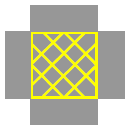 A. There are less than two vehicles in front of youB. The traffic lights show greenC. Your exit road is clearD. You need to turn left
A. There are less than two vehicles in front of youB. The traffic lights show greenC. Your exit road is clearD. You need to turn left
14. You are driving at night with full-beam headlights on. A vehicle is overtaking you. You should dip your lights
A. Some time after the vehicles has passed you
B. Before the vehicles starts to pass you
C. Only if the other driver dips his headlights
D. As soon as the vehicle passes you
15. Signals are normally given by direction indicators and:
A. Brake lights
B. Side lights
C. Fog lights
D. Interior lights
16. You are approaching a busy junction. There are several lanes with road markings. At the last moment you realise that you are in the wrong lane. You should:
A. Continue in that lane
B. Force your way across
C. Stop until the area has cleared
D. Use clear arm signals to cut across
17. There is a tractor ahead of you. You wish to overtake but you are NOT sure if it is safe to do so. You should:
A. Follow another overtaking vehicle through
B. Sound your horn to the slow vehicle to pull over
C. Speed through but flash your lights to oncoming traffic
D. Not overtake if you are in doubt
18. At a crossroads there are no signs or road markings. Two vehicles approach. Which has priority?
A. Neither vehicle
B. The vehicle the fastest
C. The vehicle on the widest road
D. Vehicles approaching from the right
19. What are the maximum national speed limits for cars and motorcycles in built-up areas and elsewhere?
A. 45mph and 100mph
B. 50mph and 80mph
C. 30mph and 70mph
D. 40mph and 70mph
20. You are reversing your vehicle into a side road. When would the greatest hazard to passing traffic occur?
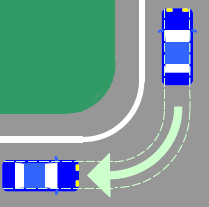 A. After you’ve completed the manoeuvreB. Just before you actually begin to manoeuvreC. After you’ve entered the side roadD. When the front of your vehicle swings out
A. After you’ve completed the manoeuvreB. Just before you actually begin to manoeuvreC. After you’ve entered the side roadD. When the front of your vehicle swings out
21. The dual carriageway you are turning right onto has a narrow central reverse. You should:
A. Proceed to central reverse and wait
B. Wait until the road is clear in both directions
C. Stop in the first lane so that other vehicles give way
D. Emerge slightly to show your intentions
22. You are going straight ahead at a roundabout. How should you signal?
A. Signal right on the approach and then left to leave the roundabout
B. Signal left as you leave the roundabouts
C. Signal left on the approach to the roundabout and keep the signal on until you leave
D. Signal left just after you pass the exit before the one you will take
23. What does a speed limit sign like this mean?
 A. It is safe to drive at the speed shownB. The speed shown is the advised maximumC. The speed shown allows for various road and weather conditionsD. You must not exceed the speed shown
A. It is safe to drive at the speed shownB. The speed shown is the advised maximumC. The speed shown allows for various road and weather conditionsD. You must not exceed the speed shown
24. You must not reverse:
A. For longer than necessary
B. For more than a car’s length
C. Into a side road
D. In a built-up area
25. You meet an obstruction on your side of the road. You should:
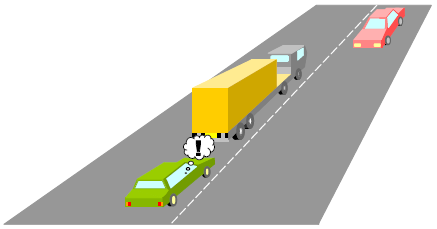 A. Drive on; it is your right of wayB. Give way to oncoming trafficC. Wave oncoming vehicles throughD. Accelerate to get past first
A. Drive on; it is your right of wayB. Give way to oncoming trafficC. Wave oncoming vehicles throughD. Accelerate to get past first
26. Someone is waiting to cross at a zebra crossing. They are standing on the pavement. You should normally:
A. Go on quickly before they step onto the crossing
B. Stop before you reach the zigzag lines and let them cross
C. Stop, let them cross, wait patiently
D. Ignore them as they are still on the pavement
27. What lights and why must you put them on when going through a tunnel?
A. Main-beam to see clearly where you are going.
B. Dipped-beam to help you see and also be clearly seen by others.
C. Dipped-beam and front and/or rear Fog lights to see and be seen clearly.
D. Hazard warning lights so nobody drives too near.
E. No lights are necessary as tunnels have their own lighting.
28. You are on a busy main road and find that you are in a wrong direction. What should you do?
A. Turn into a side road on the road on the right and reverse into the main road.
B. Make a U-turn in the main road
C. Make a ‘three point’ turn in the main road
D. Turn round in a side road
29. What is the meaning of this sign?
 A. No entryB. Waiting restrictionsC. National speed limitD. School crossing patrol
A. No entryB. Waiting restrictionsC. National speed limitD. School crossing patrol
30. While driving, you intend to turn left into a minor road. On the approach you should:
A. Keep just left of the middle of the road
B. Keep in the middle of the road
C. Swing out wide just before turning
D. Keep well to the left of the road
31. You may drive over a footpath:
A. To overtake slow-moving traffic
B. When the pavement is very wide
C. If no pedestrians are near
D. To gain lawful access into a property
32. What is the meaning of this sign?
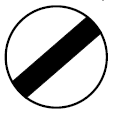 A. Local speed limit appliesB. No waiting on the carriagewayC. National speed limit appliesD. No entry to vehicular traffic
A. Local speed limit appliesB. No waiting on the carriagewayC. National speed limit appliesD. No entry to vehicular traffic
33. You are finding it difficult to find a parking place in a busy town. You can see there is space on the zigzag lines of a zebra crossing. Can you park there?
A. No, unless you stay with your car
B. Yes, in order to drop off a passenger
C. Yes, if you don’t block people from crossing
D. No, not under any circumstances
34. Which vehicle might have to use a different course than normal at roundabouts?
A. Sports car
B. Van
C. Estate car
D. Long vehicle
35. You are looking for somewhere to park your vehicle. The area is full EXCEPT for spaces marked ‘disabled use’. You can:
A. Use these spaces when elsewhere is full
B. Park if you stay with your vehicle
C. Use these spaces, disabled or not
D. Not park there unless permitted
36. Who has priority at an unmarked crossroads?
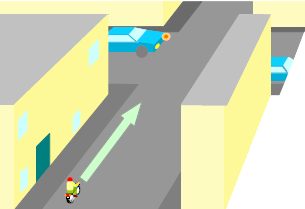 A. The driver of the larger vehicleB. No oneC. The driver who is going fasterD. The driver on the wider road
A. The driver of the larger vehicleB. No oneC. The driver who is going fasterD. The driver on the wider road
If you wish to check whether you have master these questions, you may
click on the above button to practice with questions only from this DMV topic.
If you do not have an account yet,
Sign Up one now, it is FREE!







